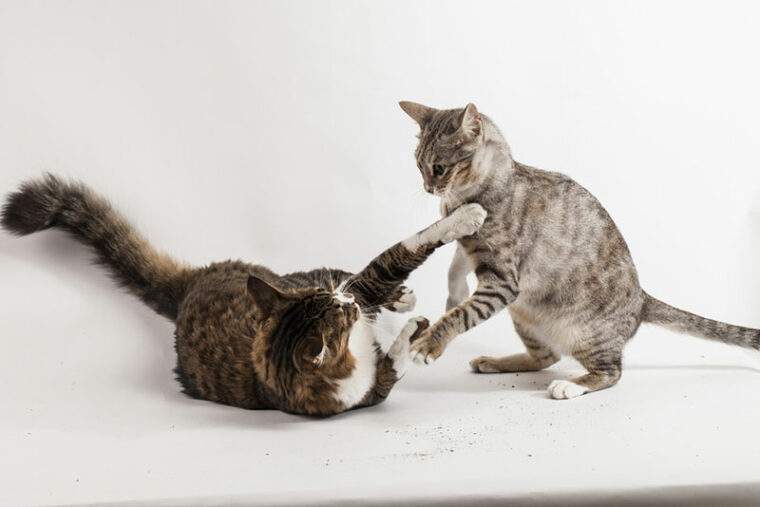
Click to Skip Ahead
Domestic cats aren’t monogamous. It’s common for male and female cats to have multiple sexual partners over their lifetimes, and mating with multiple tomcats during one estrus cycle is par for the course for female cats with access to several mates. Domestic cats don’t naturally form male-female pair bonds to raise and care for kittens; female cats largely take care of their offspring on their own.
But that doesn’t mean that cats don’t love and care deeply for those around them. They often become attached to people, dogs, and other kitties with whom they spend time and share enduring bonds of love and affection. Cats also regularly grieve when a beloved human, feline, or canine friend dies or moves away.
How Feline Reproduction Works
Cats reach sexual maturity when they’re between 4 and 12 months old, but the exact time can vary. Shorthaired cats often hit sexual maturity earlier than longhaired ones, and some breeds, such as Maine Coon and Siberian cats, can take longer to grow up. On average, female cats first go into heat when they’re between 6 and 9 months old. Estrus cycles in cats average around 3 weeks from start to finish.
Pheromones
Female cats release powerful pheromones that let male cats know they’re sexually available. Cats have scent glands that produce the chemicals around their ears, chins, and paw pads. Pheromones are also found in feline urine, which partly explains why intact cats are inclined to mark in the quest to find mates.

Ovulation
Unlike humans, cats don’t regularly ovulate but do so as a result of having sex. Multiple matings over the course of 24 hours are required for most cats to ovulate. It’s relatively common for female cats to mate with several partners during the same estrus cycle, which can result in kittens being carried at the same time who have different fathers.
Pregnancy
Cat pregnancies generally last around 2 months, and the litters usually contain anywhere from 4 to 6 kittens, but the number can go as high as 8 or 9. Cats can carry multiple pregnancies to term during a year, so over 12 months, a particularly fertile cat could theoretically give birth to more than 20 kittens.

Spaying and Neutering
Spaying and neutering pets are so important because cats can be so incredibly fertile. Desexing cats plays an important role in keeping kittens out of shelters and limiting the number of stray and feral animals. Neutering cats often reduces behavior such as fighting and peeing outside of the litter box in male cats, and it reduces the vocalization and escape attempts commonly seen when females are in heat.
Spaying also has health benefits, including reduced risks of breast, uterine and ovarian cancers. Most female cats recover from the procedure within about 2 weeks; neutering is less invasive, so male cats usually are within 5 to 7 days.
What Precisely Is Monogamy?
Scientists often discuss sexual as opposed to social monogamy. Sexual monogamy refers to the practice of only having one sexual partner, and it’s quite rare, but having multiple partners is often advantageous from an evolutionary perspective.
Social monogamy describes pair bonding that involves living together, sharing resources, and joint child-rearing. Still, it can be difficult to describe and measure, as not all deeply bonded relationships between individuals look the same. Many species that practice social monogamy don’t engage in sexual monogamy, as indicated by genetic studies.
Wolves, for instance, generally practice social monogamy, with packs built around long-lasting alpha pairs, but alpha males regularly engage in sexual activity with other partners. Social monogamy is rarely seen in mammals, but several bird species tend to pair off for life.
Fewer than 10% of mammals are considered socially monogamous, but a stunning 90% of bird species appear to be. Primates tend to be overrepresented among the socially monogamous sorts; approximately 29% stick to one partner. Ungulates such as cattle, whales, deer, and hippos have relatively few monogamous species.

Are Big Cats Monogamous?
Monogamy isn’t found among big cats such as lions, tigers, or leopards. Leopards and tigers tend to live relatively solitary lives, often only coming into contact with others for mating purposes. Leopard dads don’t interact much with their cubs but keep other adult males out of the area, which is helpful since adult male leopards are notorious for killing unrelated cubs.
Tiger fathers aren’t usually involved in raising their offspring either. Although lions spend their lives in prides that provide a social structure, female lions still aren’t monogamous. Their options, however, are usually limited to the male members of the pride. Adult male lions often kill unrelated cubs to bring female lions back into heat when attempting to shoulder their way into a pride.
Which Species Are Considered Monogamous?
Gray wolves, bald eagles, beavers, Macaroni penguins, and sandhill cranes are described as pairing off for life. Life-long pair bonding can also involve individuals of different sexes. Male Pinstrap penguins at a zoo in New York City have lived together as a pair for years, frequently grooming each other and snuggling, but researchers are now discovering that even “monogamous” species, such as Gentoo penguins, sometimes have multiple partners.
Conclusion
Cats aren’t monogamous. Male and female cats have sex with multiple partners throughout their lives, and female cats regularly mate with different males when in heat. Female cats can even carry kittens from two fathers to term at the same time! Queens do most of the kitten raising on their own, so intense pair bonding for the purpose of rearing offspring isn’t usually seen among cats.
Like domestic cats, lions, tigers, and leopards aren’t inclined to limit themselves to one partner. However, lions typically restrict their search for potential partners to members of the same pride. Cats still form deep, lasting bonds with the people, cats, and dogs they love.
Featured Image Credit: AltamashUrooj, Shutterstock





